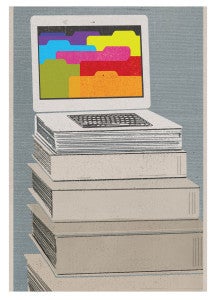
A common lament of law students is that casebooks are expensive and heavy. Others say they are static and slow to evolve. Professor Jonathan Zittrain ’95 has set out to address both complaints. Co-founder of the Berkman Center for Internet & Society, Zittrain is leading a team to create an alternative casebook that is free, online and remixable. It’s just one aspect of the Berkman Center’s suite of classroom tools called H2O, which also includes functions for editing and annotating cases, aggregating materials, and facilitating in-classroom back channel and out-of-class discussion. Current casebook user and Bulletin reporter Jill Greenfield ’12 spoke to Zittrain about the project.
Why did you develop the project?

We wanted to allow students to be exposed to the viewpoints and ideas of students not even in the classroom, who may be studying the same text at the same time within a different legal culture. The cases are all in the public domain—from the courts—so rather than have them in a bound casebook, students can see the case, annotate it, share those annotations with their study group or classmates, see last year’s annotations, and the professor or other students can critique those notations. Where it happens to coincide with another class anywhere in the world that’s studying that case, the critiques can go across oceans. That may expose students to comparative viewpoints that would otherwise be the subject of a comparative law class that many students might not take.
What effect can you see this having on legal education?
It can create a means for natural evolution of a curriculum. The reason we don’t teach law classes off the beaten path is that there are no casebooks for unusual combinations of topics. There might be material in the curriculum that is there only because of inertia, not because it’s classic. With a flexible digital platform, a professor can easily drag and drop edited cases from others’ syllabi into a basket, like shopping on Amazon.com, and then edit to taste, as much or as little as desired. We might see, through micro adjustments, a sort of macro evolution. There can be new canons formed one step at a time. Genealogies can be automatically maintained so that professors can see who is influencing whom—a coin of the academic realm.
You have assigned the online casebook to your Torts class this year. How is it working in practice?
It’s a transition. Some students like it; some don’t. One of the anchor points in a first-year class is that students know exactly what reading is assigned. Materials that are more open-ended, as on H2O, where students can click to see omitted portions of edited cases, can create questions about workload. The transition to the online casebook has illustrated that it is not just about technology—it’s also about norms and practices.
Do you see this platform having other uses outside academia?
These tools are envisioned for anyone who wants to build community around an idea. Ultimately what I would like to see built is a way for people of good faith who want to get to the bottom of a complex and rapidly evolving issue to put their questions on the table and have them answered with degrees of varying authority. I can see that being useful in a law school environment, where you’re learning to argue and back it up with facts, and it will be beneficial to the world at large where “truthiness”—arguing from predetermined outcomes with little regard for facts or argument—too often holds sway.